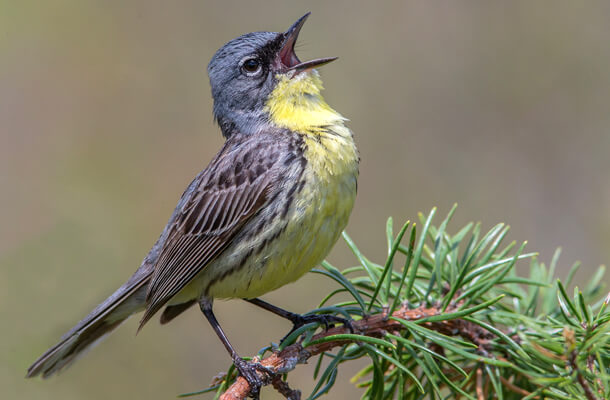Success for Kirtland's Warbler Doesn't Mean the Work is Over

Kirtland's Warbler recently secured the support of the Towsley Foundation, which will fund continued management efforts for this conservation-reliant species. Photo by Peter Tamas
Thanks to an intensive, decades-long effort from many partners in the wildlife conservation community, the Kirtland's Warbler is an Endangered Species Act (ESA) success story. Bordering on extinction with a population of approximately 200 singing males in the mid-1970s, this habitat specialist, which breeds on large tracts of young jack pine forests in the Great Lakes region and winters in select areas of the Bahamas, has rebounded to include more than 2,000 breeding pairs today.
This progress doubles the original goal set by the U.S. Fish and Wildlife Service (USFWS). As a result, the USFWS proposed removing the species from the Endangered Species List earlier this year. Delisting is an indicator of the Kirtland's Warbler's hard-fought recovery, but the species will require long-term habitat management and ongoing support to continue to thrive.
Thanks to major philanthropic support from the Harry A. and Margaret Towsley Foundation, American Bird Conservancy is working with a range of agency and nonprofit partners to develop a comprehensive strategy that addresses the full life-cycle conservation needs of the species after delisting.
“Delisting the Kirtland's Warbler means the loss of ESA funding for conservation initiatives, so we're grateful to the Towsley Foundation for providing leadership and support to define a long-term strategy,” said Shawn Graff, ABC's Vice President for the Great Lakes Region. “This species is conservation-reliant, meaning that continued management efforts are imperative for the population to hold its ground and continue to expand. That's what makes this work and Towsley's investment so critically important.”
The Michigan-based Towsley Foundation is funding a three-year effort to develop a Kirtland's Warbler Business Plan that will define and coordinate essential conservation and research activities, along with a fundraising strategy to ensure this work continues in the future. Meanwhile, the establishment of a Kirtland's Warbler endowment will allow concerned citizens and organizations to invest in the bird's long-term recovery.
“Partnerships saved the Kirtland's Warbler from extinction,” said Scott Hicks, Field Supervisor in USFWS's Michigan Ecological Services Field Office. “We welcome efforts by the Towsley Foundation and ABC to build on that legacy by helping to support the conservation of this species into the future."
Among other initiatives, the Towsley grant is supporting the addition of Dr. David Ewert to the American Bird Conservancy team as Kirtland's Warbler Program Director. Ewert previously served as the Director of Conservation Science for The Nature Conservancy's Great Lakes Program and is one of the leading researchers and conservationists focused on the species' recovery. He serves on the board of the Kirtland's Warbler Alliance and is active on both the Kirtland's Warbler Conservation Breeding Range and Non-breeding Committees.
Kirtland's Warbler was among the first species listed when the ESA was enacted in 1967. At that time, the warbler was found only in a few isolated areas of Michigan's Lower Peninsula during the breeding season. The species has surpassed recovery goals for the past 16 years and continues to increase in its stronghold in Michigan's Lower Peninsula, while expanding its breeding range into areas of Michigan's Upper Peninsula, Wisconsin, and Canada.
Graff states that Huron Pines, the Kirtland's Warbler Alliance, and many other nonprofit partners have devoted countless hours on conservation and research efforts and will play an important role in the warbler's future success. In addition to the Towsley Foundation's support, the Michigan Department of Natural Resources and the U.S. Forest Service are also pledging their commitment to continue management and engage in partnerships that support the Kirtland's Warbler's population growth.
“The Kirtland's Warbler success story is an excellent example of how innovative partnerships among state and federal agencies, NGOs, and private philanthropy interests can redefine how real conservation programs work on the ground,” said Bill O'Neill, Natural Resources Deputy for the Michigan Department of Natural Resources. “The broad support for removing this iconic species from protections afforded by the ESA is a testament to the commitments of all the parties interested in the long-term well-being of this unique population of songbirds.”
“The Forest Service has been collaborating and contributing to the recovery of the Kirkland's Warbler since the very beginning,” said Tracy Grazia, Regional Wildlife Program Manager for the Eastern Region of the U.S. Forest Service. “The proposed delisting is great news for the species, and we are committed to actively managing National Forest lands to provide quality habitat so the population can continue to grow and flourish in Michigan and Wisconsin.”
#####
American Bird Conservancy is dedicated to conserving birds and their habitats throughout the Americas. With an emphasis on achieving results and working in partnership, we take on the greatest problems facing birds today, innovating and building on rapid advancements in science to halt extinctions, protect habitats, eliminate threats and build capacity for bird conservation. Find us on abcbirds.org, Facebook, Instagram, and Twitter (@abcbirds1).
The Harry A. and Margaret Towsley Foundation is a Michigan-based charitable foundation. The Foundation has been funding education and scientific organizations in the state since 1959.


















































